Dashboards organize your data in a meaningful way and turn it into a business tool that helps to keep an eye on KPI's and to point your business in the right direction. Custom dashboards make it possible to visually depict performance of a website, specific traffic source or a campaign at the desired level of detail.
There is a great variety of tools that can be used for dashboarding.
Google analytics native interface dashboards.
This is a free tool by google that can be helpful in most cases, expecially for very basic tracking configuration. It helps to make quick overview of the KPI.
- Easy to create, customize and share among the authorized users
- Can be downloaded in PDF format and schedlued to be send by email
- Custom segments and timeframes (including compare with previous period feature) can be applied to dashboard.
- There are a lot of pre-configured dashboards that are shared in GA gallery and on other website in the internet.
- Each widget can be linked to the report that provides more information on the issue.
- Color and graphic style cannot be changed
- Layout is not mobile friendly
- Logo or any custom information cannot be added to the dashboard
- Comments cannot be added to widgets
- Names of metrics and dimensions cannot be change to make them more understandable
- Calculations cannot be applied to metrics
- Each Dashboard can contain up to 12 widgets and not more
- On each table chart maximum 1 dimension and 2 metrics can be displayed.
- It is not possibe to display two types of events in one table chart.
- There is a limited number of charts that can be used (stacked bar charts, scatter plots, area charts, spider charts, etc. are missing)
- Funnels cannot be displayed on the dashboards.
- Dashboard cannot be shared with non-authorized users (one can only download and send it in PDF)
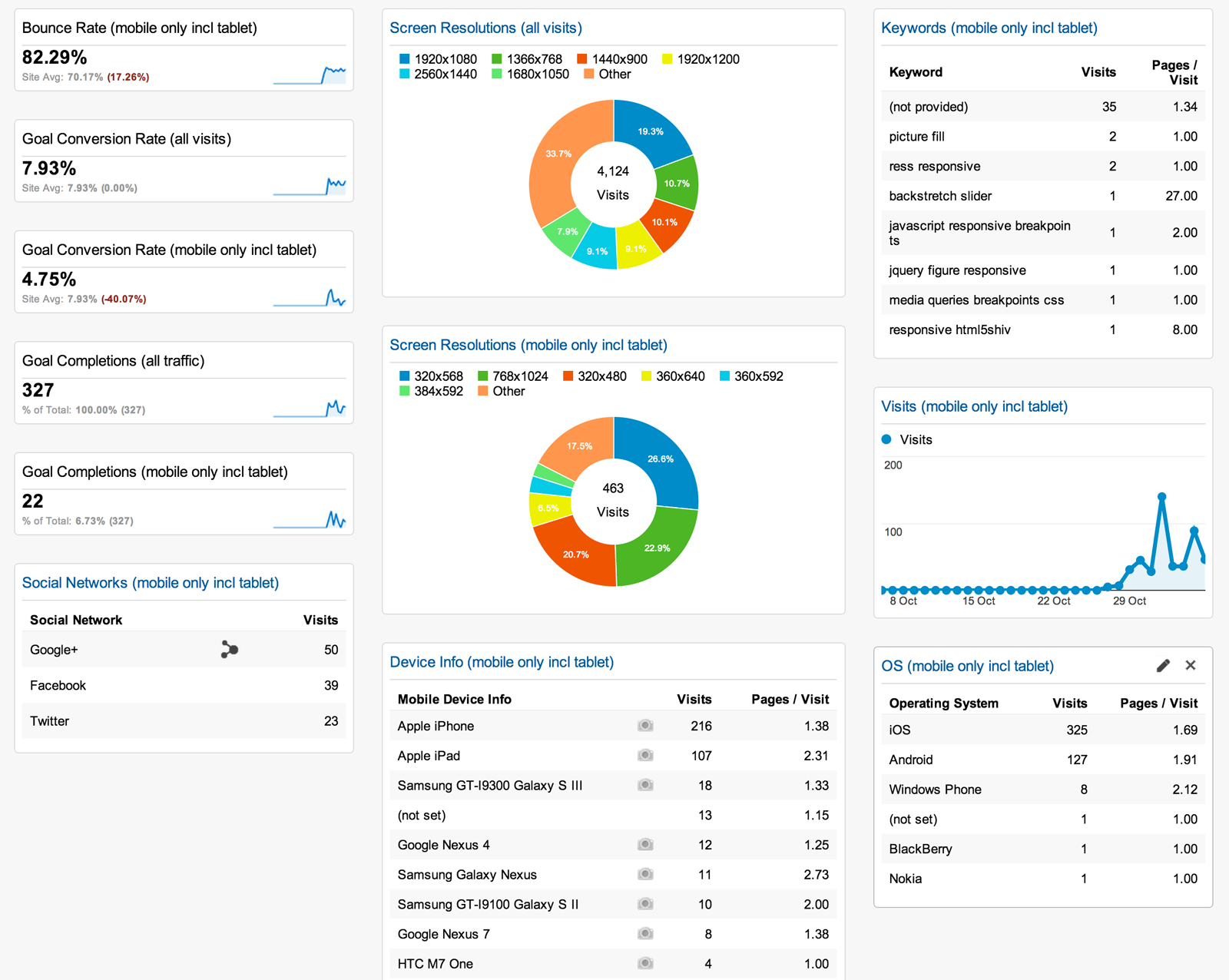

Custom Dashboard Services
There is a number of services that make it possible to create custom dashboards. They differ in sources that can be used for dashboard creation (most of them allow to connect Google Analytics, Google Adwords, Facebook, Google Spreadsheets and more). One can create custom dashboards using any of these data sources or combine them.
Custom dashboards normally have more flexibility in design and one needs to pay monthly for the dashboards.
Klipfolio
This is the most popular among all of the dashboarding tools. It helps to connect a great variety of data sources in a very flexible way. Any calculations and data manipulation can be applied.
Here is a gallery of dashboards that are created with Klipfolio https://www.klipfolio.com/resources/dashboard-examples
Pricing: starting from 24$/month - 10 dashboards and 5 users
- 100+ data sources
- Great opportunities for data manipulation
- Great variety of charts to choose from https://support.klipfolio.com/hc/en-us/articles/217238277-What-visualization-styles-can-I-use-
- One can share a dashboard publicly
- Starter pricing option is 24$/month and allows to have 10 dashboards and 5 users
- It will take time and effort to configure the dashboard you need.
- Klipfolio is very limited from the point of graphic design: it has only 2 basic color styles: light and dark. Custom logo can be also uploaded to brand the dashboard.
- Publicly shared dashboards will have Klipfolio logo and link.
- Can display data from one view only

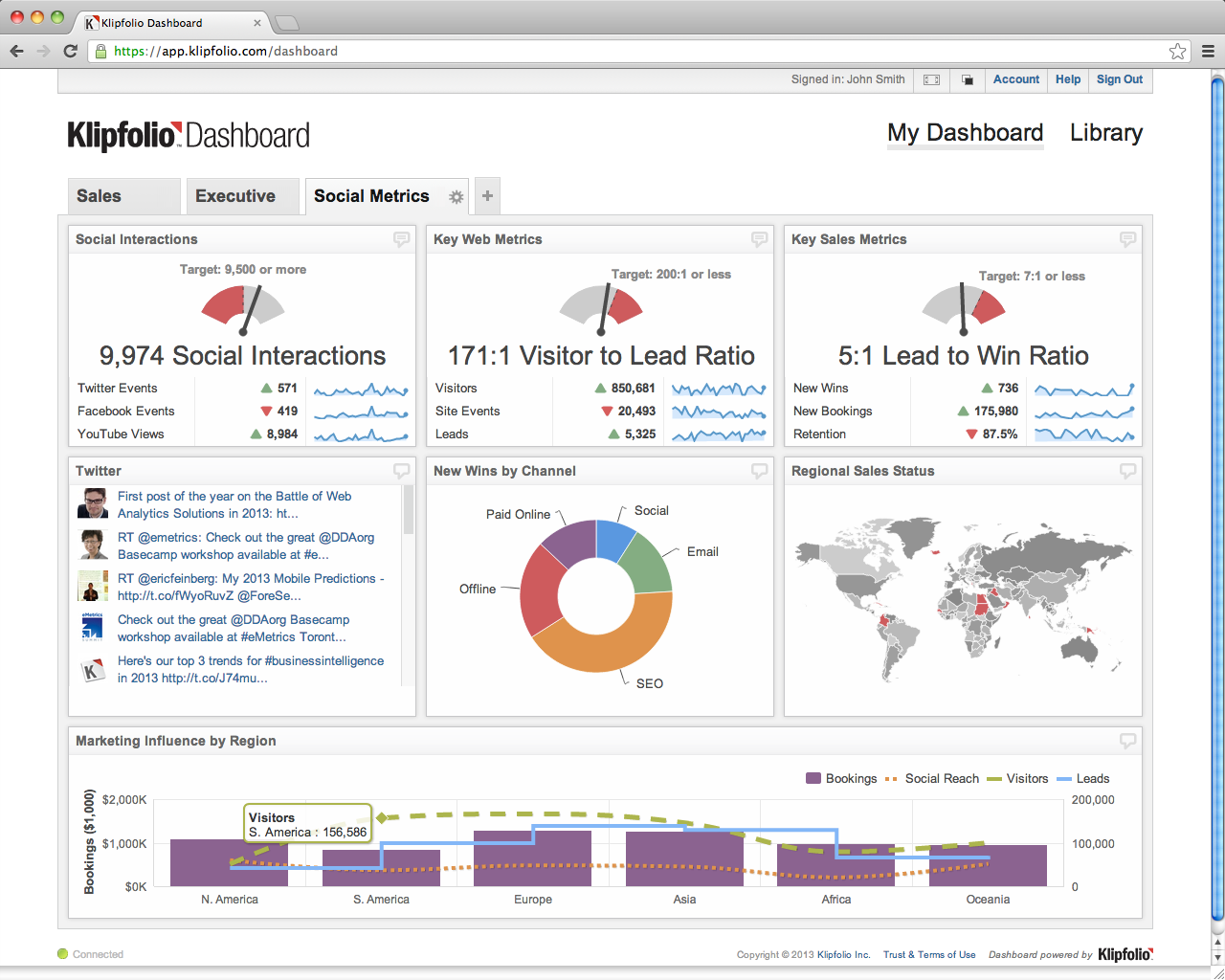
Geckoboard
Similar to Klipfolio it can integrate a large variety of data sources.
It have nice flat graphic style by default which can be however customized with the help of CSS which makes it really flexible from the graphic style point of view.
Here can be found some dashboard examples created in Geckoboard (all are shown in the default style so)
https://www.geckoboard.com/learn/dashboard-examples/
Pricing: starting from 25$/month - one dashboard and one user
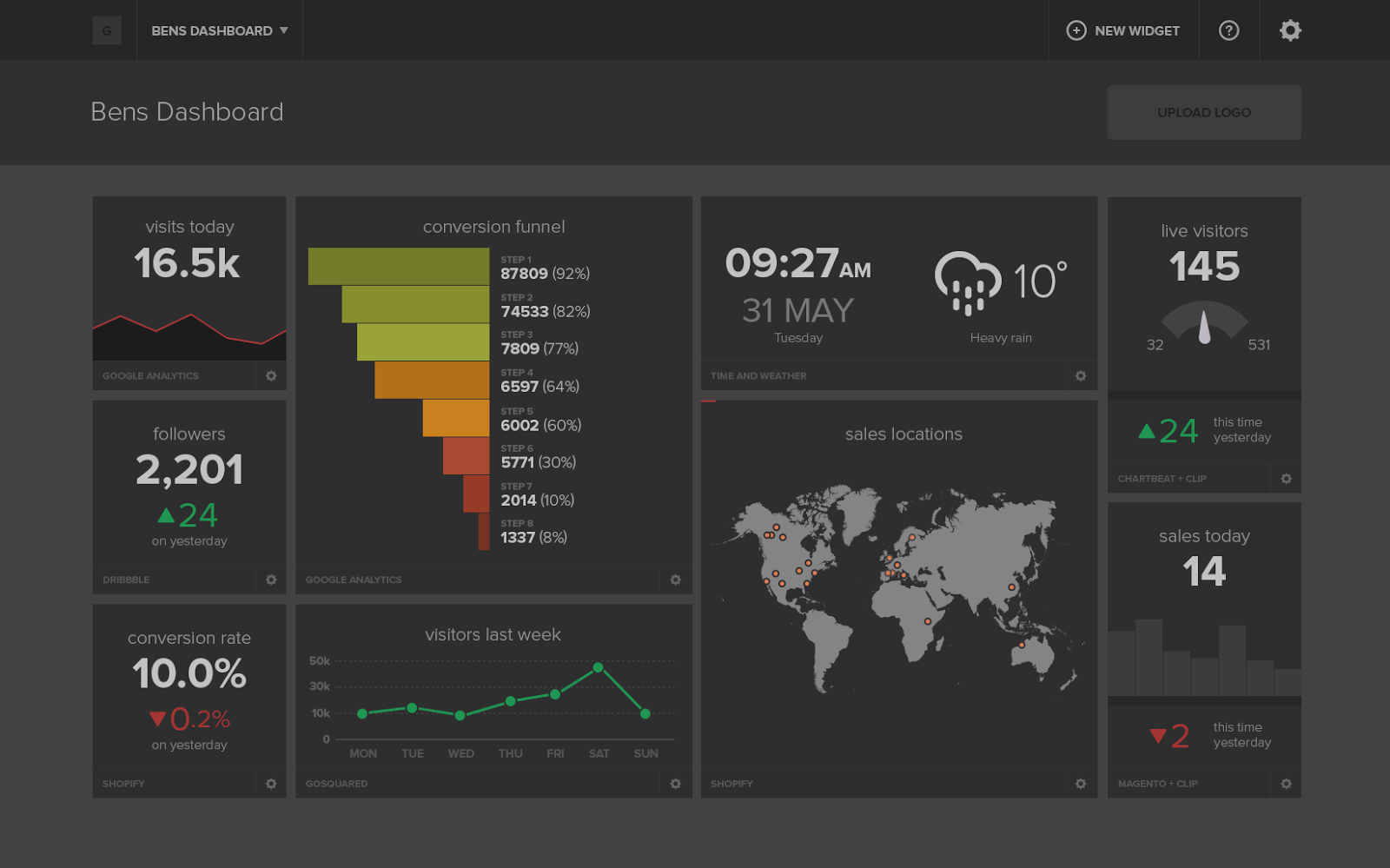
Dasheroo
Another dashboarding service that provides integration to a large variety of data sources. It is quite flexible from the layout point of view but is less documented.
Pricing: Have free account option.
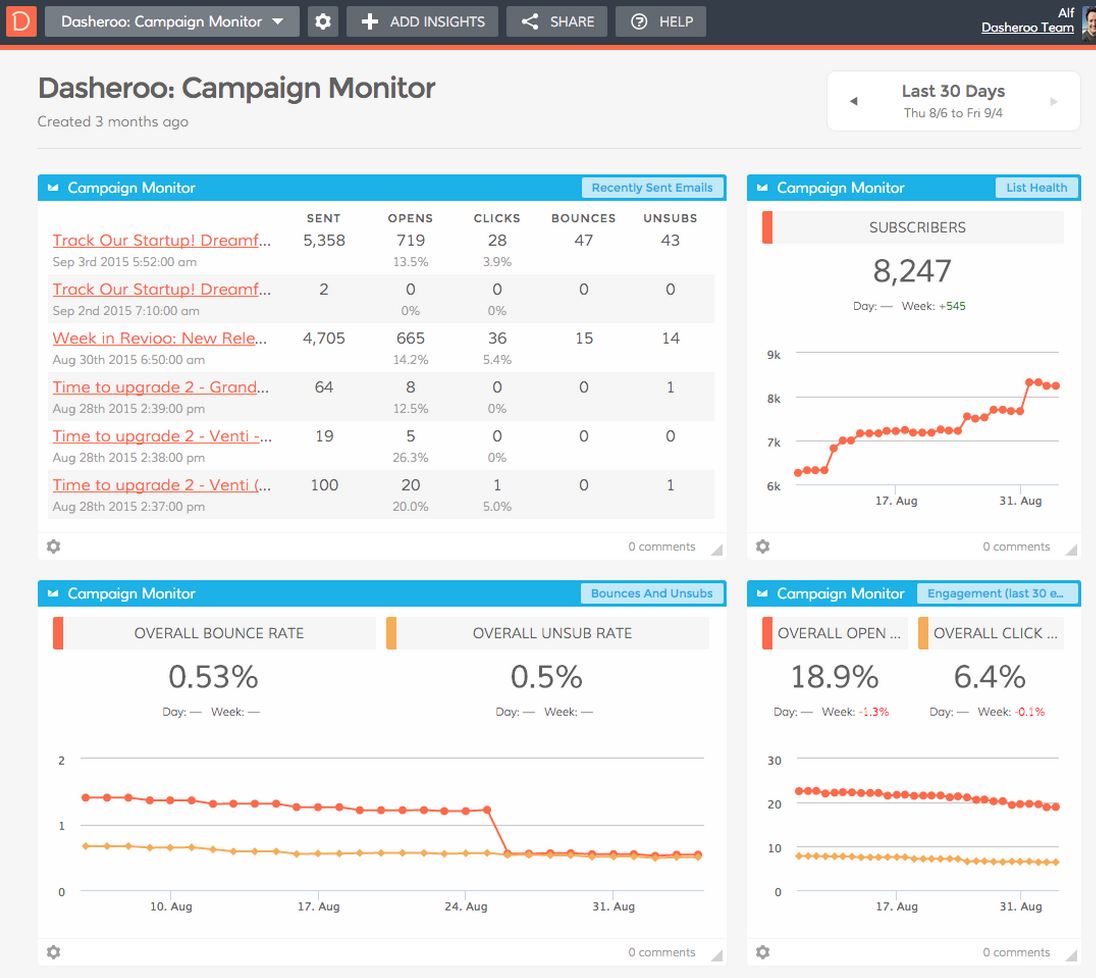
Dashthis
Can integrate a varienty of data sources and custom design.
Pricing: starting from 39$/month - 3 dashboards and one user
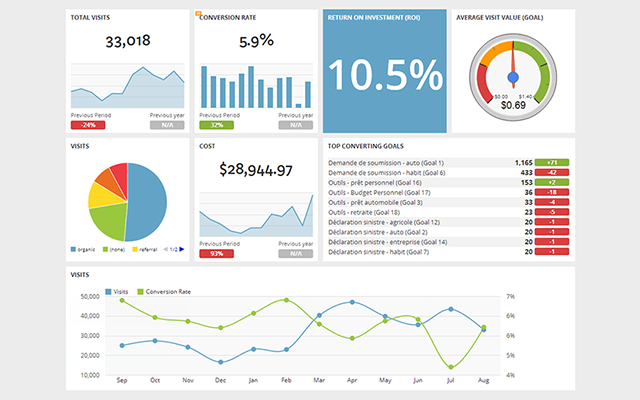

The following resource will be useful to compare the services in case you have decided to choose this option for your dashboard https://www.getapp.com/business-intelligence-analytics-software/a/klipfolio-dashboard-for-web-and-mobile/compare/dasheroo-vs-domo-vs-geckoboard/
Spreadsheet and Excel add-ons
Having dashboard in google spreadsheets and excel has some advantages for developers of data-driven solutions. The data can be analyzed and manipulated by excel and spreadsheets that were designed for this very purpose and so have really great tools.
The most popular of them are:
- Google Analytics (free)
- Supermetrics (has a free pricing option if it is used only for google analytics)
- Analytics Canvas (free)
- Tatvic Analytics Excel plugin (has a free pricing option if is used only for google analytics)
Plugins are normally used to take the data from your Google analytics account and all the other manipulations are performed either in google spreadsheets or in excel. So there are some limitations that are caused by this approach.
- Easy to grab data from account
- Great tools for data manupulation
- Data from several views and segments can be used in one dashboards
- Different timeframes can be compared or used to show progress
- Conditional formating can be used to highlight metrics.
- Custom graphics and color styles can be used to brand the report
- Large choice of charts.
- Custom graphics can be used to vizualize funnels and speedometer charts
- Can be scheduled to be send by email in pdf or as a link to spreadsheet.
- Dynamic charts can be exported and published on any pages in internet.
- Not interactive. One cannot change timeframe and update the dashboard on the fly.
- Layout is table-based and not very flexible.
- When printed into PDF some flaws become visible (some borders between cells, etc.)
- Layout is not mobile friendly
- Requires knowlenge of google analytics API to write requests

Open this dashboard in Google Spreadsheets

Open this dashboard in Google Spreadsheets
Google Looker Studio
Looker Studio from Google is a new tool in Google eco system that turns data into informative reports and dashboards that are easy to read and easy to share. It is currently in beta-testing stage and it is possible to edit and create reports only from USA (if you are not from the USA you will have to use VPN to create and edit the reports). But after the report is created it can be viewed by a user from any location in case the access is allowed by the owner.
Looker Studio is built for creating data visualizations without writing any code. Report configuration is done in intuitive visual interface which gives an ability to change colors, styles, fonts, insert images, use different charts, etc.
Looker Studio makes it possible to combine data from multiple sources on one dashboard and use it to create dynamic reports. Currently the data from the following sources can be used in Looker Studio:
- AdWords
- Attribution 360
- BigQuery
- DoubleClick Campaign Manager (DCM)
- Firebase (via BigQuery)
- Google Analytics
- Google Cloud SQL
- Google Sheets
- MySQL
- PostgreSQL
- YouTube Analytics
Once created the report can be shared with other people over internet same way as google docs or google spreadsheets.
- Free
- Easy to create and customize in visual interface
- Any graphic style and layout can be used. No limits.
- Easy to share
- A number of connectors is available
- Live and interactive.
- Has a number of template available.
- It is not supported on mobile
- There is no easy way to visualize Funnels.
- Does not support Google Analytics real-time data.
- Does not report if the data in the reports is sampled or not.
- Does not support multi-channel reports.
- PDF export for multi-page reports is not automated (you need to print each page in a separate file and combine them manually).
- Does not have free facebook, twitter, instagram, etc. connectors.
